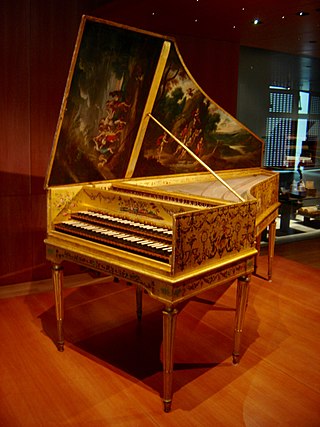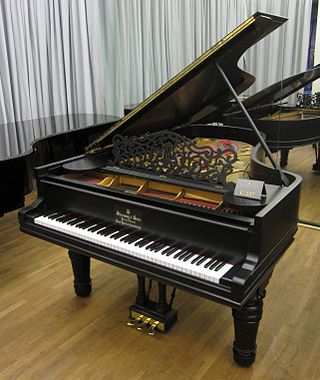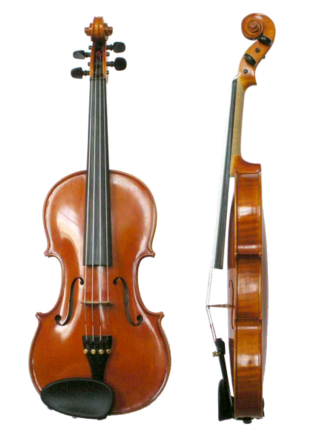Related Research Articles

A harpsichord is a musical instrument played by means of a keyboard. This activates a row of levers that turn a trigger mechanism that plucks one or more strings with a small plectrum made from quill or plastic. The strings are under tension on a soundboard, which is mounted in a wooden case; the soundboard amplifies the vibrations from the strings so that the listeners can hear it. Like a pipe organ, a harpsichord may have more than one keyboard manual, and even a pedal board. Harpsichords may also have stop buttons which add or remove additional octaves. Some harpsichords may have a buff stop, which brings a strip of buff leather or other material in contact with the strings, muting their sound to simulate the sound of a plucked lute.

A harmonic series is the sequence of harmonics, musical tones, or pure tones whose frequency is an integer multiple of a fundamental frequency.

The piano is a keyboard instrument that produces sound when pressed on the keys. Most modern pianos have a row of 88 black and white keys: 52 white keys for the notes of the C major scale and 36 shorter black keys raised above the white keys and set further back, for sharps and flats. This means that the piano can play 88 different pitches, spanning a range of a bit over seven octaves. The black keys are for the "accidentals", which are needed to play in all twelve keys.

The violin, sometimes known as a fiddle, is a wooden chordophone in the violin family. Most violins have a hollow wooden body. It is the smallest and thus highest-pitched instrument (soprano) in the family in regular use. The violin typically has four strings, usually tuned in perfect fifths with notes G3, D4, A4, E5, and is most commonly played by drawing a bow across its strings. It can also be played by plucking the strings with the fingers (pizzicato) and, in specialized cases, by striking the strings with the wooden side of the bow.

An overtone is any resonant frequency above the fundamental frequency of a sound. In other words, overtones are all pitches higher than the lowest pitch within an individual sound; the fundamental is the lowest pitch. While the fundamental is usually heard most prominently, overtones are actually present in any pitch except a true sine wave. The relative volume or amplitude of various overtone partials is one of the key identifying features of timbre, or the individual characteristic of a sound.

String instruments, stringed instruments, or chordophones are musical instruments that produce sound from vibrating strings when a performer plays or sounds the strings in some manner.

A transposing instrument is a musical instrument for which music notation is not written at concert pitch. For example, playing a written middle C on a transposing instrument produces a pitch other than middle C; that sounding pitch identifies the interval of transposition when describing the instrument. Playing a written C on clarinet or soprano saxophone produces a concert B♭, so these are referred to as B♭ instruments. Providing transposed music for these instruments is a convention of musical notation. The instruments do not transpose the music; rather, their music is written at a transposed pitch. Where chords are indicated for improvisation they are also written in the appropriate transposed form.

Bartolomeo Cristofori di Francesco was an Italian maker of musical instruments famous for inventing the piano.
Piano acoustics is the set of physical properties of the piano that affect its sound. It is an area of study within musical acoustics.

A spinet is a smaller type of harpsichord or other keyboard instrument, such as a piano or organ.
The short octave was a method of assigning notes to keys in early keyboard instruments, for the purpose of giving the instrument an extended range in the bass range. The rationale behind this system was that the low notes F♯ and G♯ are seldom needed in early music. Deep bass notes typically form the root of the chord, and F♯ and G♯ chords were seldom used at this time. In contrast, low C and D, both roots of very common chords, are sorely missed if a harpsichord with lowest key E is tuned to match the keyboard layout. A closely related system, the broken octave, added more notes by using split keys: the front part and the back part of the (visible) key controlled separate levers and hence separate notes.

The virginals is a keyboard instrument of the harpsichord family. It was popular in Europe during the late Renaissance and early Baroque periods.
The Ruckers family were harpsichord and virginal makers from the Southern Netherlands based in Antwerp in the 16th and 17th century. Their influence stretched well into the 18th century, and to the harpsichord revival of the 20th.

A flue pipe is an organ pipe that produces sound through the vibration of air molecules, in the same manner as a recorder or a whistle. Air under pressure is driven through a flue and against a sharp lip called a labium, causing the column of air in the pipe to resonate at a frequency determined by the pipe length. Thus, there are no moving parts in a flue pipe. This is in contrast to reed pipes, whose sound is driven by beating reeds, as in a clarinet. Flue pipes are common components of pipe organs.
An organ pipe, or a harpsichord string, designated as eight-foot pitch (8′) is sounded at standard, ordinary pitch. For example, the A above middle C in eight-foot pitch would be sounded at 440 Hz.
The oval spinet is a type of harpsichord invented in the late 17th century by Bartolomeo Cristofori, the Italian instrument maker who later achieved fame for inventing the piano. The oval spinet was unusual for its shape, the arrangement of its strings, and for its mechanism for changing registration.
Hieronymus Albrecht Hass was a German harpsichord and clavichord maker. He was the father of Johann Adolph Hass, who also made harpsichords and clavichords.

The harpsichord was an important keyboard instrument in Europe from the 15th through the 18th centuries, and as revived in the 20th, is widely played today.

The spinettone was a kind of harpsichord invented in the late 17th century by Bartolomeo Cristofori, who was later the inventor of the piano. Other names for this instrument were spinettone da teatro, spinetta traversa.

Mechanical music technology is the use of any device, mechanism, machine or tool by a musician or composer to make or perform music; to compose, notate, play back or record songs or pieces; or to analyze or edit music. The earliest known applications of technology to music was prehistoric peoples' use of a tool to hand-drill holes in bones to make simple flutes. Ancient Egyptians developed stringed instruments, such as harps, lyres and lutes, which required making thin strings and some type of peg system for adjusting the pitch of the strings. Ancient Egyptians also used wind instruments such as double clarinets and percussion instruments such as cymbals. In Ancient Greece, instruments included the double-reed aulos and the lyre. Numerous instruments are referred to in the Bible, including the horn, pipe, lyre, harp, and bagpipe. During Biblical times, the cornet, flute, horn, organ, pipe, and trumpet were also used. During the Middle Ages, hand-written music notation was developed to write down the notes of religious Plainchant melodies; this notation enabled the Catholic church to disseminate the same chant melodies across its entire empire.
References
- Hubbard, Frank (1967) Three Centuries of Harpsichord Making. Cambridge, MA: Harvard University Press; ISBN 0-674-88845-6.